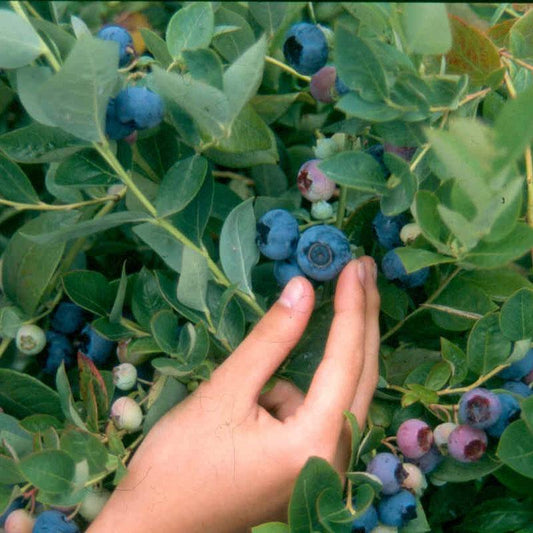The fundamental considerations and subtle nuances of growing and caring for blueberries are beyond the scope of this introduction to plant care. Please see our Resource Center where we offer additional instructional videos and articles, as well as our bookstore.
Cultural Requirements
Delicious, exceptionally nutritious and high in bioflavanoids. Gardeners in warmer climates can enjoy growing blueberries by choosing one of the Southern Highbush blueberry varieties. These require fewer chill hours than the Northern Highbush blueberries which require over 1,000 hours.
Consider climate suitability, ripening season and fruit size when selecting varieties and include at least two different varieties for cross-pollination and fruiting (any two varieties will do, regardless of ripening time). Plan to grow blueberries in acidic soil, which is well-drained. Cottonseed meal is an excellent fertilizer for blueberries along with good quality compost.
Mulching with acidic materials has proved beneficial for soils that are not ideal for blueberry growing. Fir sawdust or bark dust, applied at a depth of two to four inches, also eliminates most of the need for cultivation and conserves moisture. Blueberries’ shallow, compact root system makes regular irrigation a necessity.
Heeling In
When your bare root blueberry plants arrive, open the plastic bags immediately. It is best to plant right away, within a week of delivery, however if you cannot plant right away, you may “heel in” the plants. This protects them and keeps them alive (but still dormant) until you are able to plant them in their permanent spot.
Outdoors: To heel in bare root blueberries outside, pick a location that is shielded from wind. Next, dig a trench for the berries about twice as deep as the roots are long. Place in the hole roots side down and cover the roots with soil or sand and gently tamp down to avoid air pockets. Check the root area from time to time, keeping the soil moist.
Indoors: To heel in bare root blueberries indoors, whether due to snow or a frozen ground, choose a cool place like a root cellar, basement, or garage. It is important to choose a place where the temperature stays between 38°F and 45°F. This is important so the roots neither freeze, nor does the plant break dormancy. Place the roots in a container with soil or sand and be sure to keep the root area moist.
Potted Varieties: If your blueberries arrive potted and you are not ready to plant, just keep them in the pot and watered. Keep the plants in a location that stays between 38°F and 45°F.
Planting
Blueberries ultimately can reach a height of 6’ or more with a spread of 4’ or more. Therefore, the rows should be at least 8’ apart with plants spaced no closer than 6’ apart, unless a hedge is desired. The top of the root clump should be close to the surface if a mulch is used or about 4” deep without mulch.
If you are planting bushes in pulp pots score the sides of the pots and remove the bottom of the pot before you plant the bush and pot in the ground. Blueberries are also very adaptable to container culture. Do not mulch your blueberries with bark or saw dust from cedar or redwood trees.
Potted Varieties: Plan to plant the blueberries in the spring or late winter. Space them according to the variety and at the same level as they are in the pot.
Fertility
For mineral soils that are well-balanced, a yearly application of a high acid organic fertilizer is ideal. It should be applied in early spring, on the surface of the mulch in a broad ring around the plant, regardless of plant size. The regular addition of phosphorus is important for fruit production. Periodic testing will show whether soil pH and nutrient needs are being met.
Fruit Production
Two different varieties must be planted to ensure cross-pollination and fruit set. Any two varieties will cross-pollinate regardless of ripening time. The early varieties begin ripening in June and the late varieties in early August.
When planting two or three year old plants, the blossoms should be removed for a year or two to promote vegetative growth and development of a strong root system. Blueberries tend to over-bear rather than under-bear. Thinning blossoms will promote larger fruit and a healthier bush. A mature bush may produce 15 to 20 pounds of fruit.








